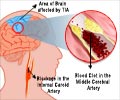Researchers have found that the process of restoring low levels of protein is useful in treating patients with critical limb ischemia (CLI).

Past studies have shown that returning the protein to normal levels or above prevented and/or reversed congestive heart failure in large animal models with gene therapy. Given these new findings, the researchers posit that S100A1 could also be a potential therapeutic target in CLI to promote revascularization.
The team was led by Patrick Most, M.D. , adjunct Assistant Professor of Medicine at Thomas Jefferson University, and lead author of the study who now heads the Center for Molecular and Translational Cardiology at the University of Heidelberg, Germany, and Karsten Peppel, Ph.D., an Associate Professor in the Center for Translational Medicine at Jefferson and senior author of the study.
"In patients with CLI, this protein appears to be reduced to extremely low levels, almost non-existent," said Dr. Peppel. "This dovetails with a finding we had when we were looking at patients with heart failure. We already know this protein has an important role in heart muscle cells. In patients who experience heart failure, there was reduced amount of the protein, down to about 40 percent of normal. Here, we showed in mice with CLI a similar defect in vascular cells and the inability to re-vascularize following arterial occlusion."
Without successful revascularization, up to 40 percent of patients with CLI require major limb amputations within a year of diagnosis. CLI has many of the same predisposing risk factors as arteriosclerosis, such as smoking, high blood pressure and Type 2 diabetes. According to the American Diabetes Association, there are over 65,000 lower limb amputations performed in the United States a year as a direct result of diabetes.
"Understanding the fundamentals of disease mechanisms is key to finding better therapies. This actually exceeds the capacity of one laboratory," said Dr. Most. "Our integrative model of sharing expertise and resources between our laboratories in the U.S. and Germany has proven to be quite successful over the last years."
Advertisement
S100A1, part of a larger family of proteins called S100, is primarily found at high levels in muscle, particularly the heart. Falling levels of S100A1 are critical in the loss of heart-pumping strength after a heart attack and play an important role in the progression to heart failure.
Advertisement
"The mechanism is based more or less on the availability of nitric oxide," said Dr. Most. "S100A1 also regulates calcium cycling in the endothelial cell, and calcium is needed in the endothelial cell to stimulate nitric oxide production. The loss of S100A1 impairs the calcium mobilization of the endothelial cell – that's the link between less calcium, less nitric oxide, hypertension and endothelial dysfunction."
"Now, we have shown a down regulation of S100A1 in patients with CLI and identified the protein as critical for endothelial cell function in ischemic angiogenesis," he said. "This is a new therapeutic angle. Perhaps the most intriguing finding is that S100A1 stimulates directly the source enzyme of nitric oxide in endothelial cell. Without S100A1, this mechanism is simply blocked and the body's ability to generate new small vessels severely compromised."
The next step is to determine what causes that down regulation and look for therapeutic development, according to the researchers, adding that they will take advantage of the unique expertise and experience in developing molecular-targeted therapies at the Center.
"Our goal is to determine why these levels drop in patients with peripheral arterial occlusive disease, and how we can get them back up, and if restoration of this protein makes it better," said Dr. Peppel. "There is potential with therapeutics, mainly gene therapy, to restore levels and possibly improve revascularization, not only in patients with CLI but also in heart disease due to insufficient blood supply."
Source-Eurekalert














